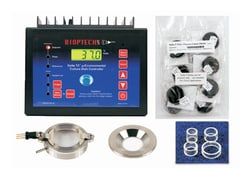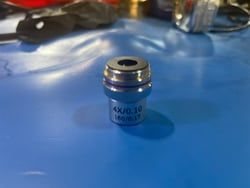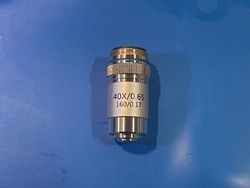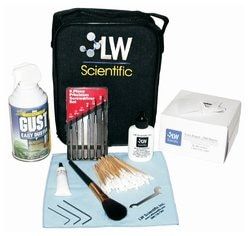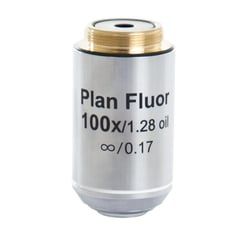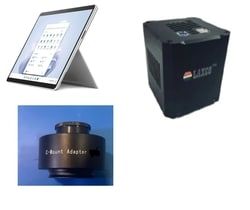12-563-663
Invitrogen™ Olympus™ 60X Objective, fluorite, 0.90NA/0.2WD, correction collar (0.11–0.23 mm)
Manufacturer: Invitrogen™
Select a Size
| Pack Size | SKU | Availability | Price |
|---|---|---|---|
| Each of 1 | 12-563-663-Each-of-1 | In Stock | ₹ 4,02,725.00 |
12-563-663 - Each of 1
In Stock
Quantity
1
Base Price: ₹ 4,02,725.00
GST (18%): ₹ 72,490.50
Total Price: ₹ 4,75,215.50
Type
60X Objective, Fluorite, NA 0.90, WD 0.2 mm, Correction Collar (Vessel Thickness 0.11 – 0.23 mm)
Autoclavable
Not Autoclavable
For Use With (Application)
Imaging
Material
Fluorite
Product Line
EVOS, High-Content Screening (HCS)
Description
60X Objective, Fluorite, NA 0.90, WD 0.2 mm, Correction Collar (Vessel Thickness 0.11 – 0.23 mm)
Includes
Vessels
Description
- This fluorite (semi-apochromat) objective is equipped with an adjustable collar that affords flexibility in imaging through vessels with a thickness from 0.11 to 0.23 mm
- With four-color correction for spherical and chromatic aberrations, it delivers exceptional image quality
- For the sharpest image simply set the collar to the thickness of the vessel/coverslip you are using
- If the thickness is unknown, turn the collar in either direction while monitoring the sample focus
- All Olympus objectives are compatible with EVOS cell imaging systems and offer outstanding optical performance from visible to near-infrared light
- The extensive selection of EVOS and Olympus objectives satisfies needs across the spectrum of magnifications and optical specifications
- Additional characteristics of this Olympus objective: Magnification : 60X Numerical Aperture : 0.90 Working Distance : 0.2 mm Superb image quality Image quality Microscope objectives may be the most important components of a microscope because they are responsible for primary image formation
- High image quality is crucial to experimental success and often a requirement for publication; Olympus objectives afford that quality across the visible spectrum to near infrared light
- This performance results from years of lens manufacture experience, and the broad selection of objectives means that you can choose the optimal objective for your imaging requirements
- Objective classes Achromat objectives are perfect for general applications, with standard correction of color and focus
- Fluorite objectives deliver excellent resolution and are made with higher numerical apertures than achromat objectives, resulting in brighter fluorescence signal and higher contrast imaging
- The higher optical quality greatly reduces optical aberrations, and corrections for color and focus are at higher levels than achromat objectives
- Fluorite objectives are ideally suited for fluorescence and demanding transmitted light applications, where the higher contrast make them ideally suited for color imaging
- Apochromat objectives are manufactured to the highest levels of resolution, fluorescence brightness, and contrast; chromatic aberrations are almost eliminated
- They are recommended for the most demanding applications, particularly at magnifications of 60x and above
- Apochromatic objectives are the best choice for the capture of color images in white light
- Brightfield contrast versus phase contrast objectives Brightfield is the most basic form of light microscopy and is accomplished by sample absorption of light
- A higher density area in a sample will absorb more light, thus increasing contrast in those areas
- Phase contrast objectives are most useful for hard to see, translucent specimens
- This method of contrast is accomplished by converting phase shifts, caused by light passing through a translucent specimen, into brightness changes (i.e., contrast)
- Long working distance versus coverslip-corrected objectives Long working distance (LWD) objectives are optimized for use through vessels with a nominal wall thickness of 0.9-1.5 mm
- This includes vessels commonly used in cell culture and cell-based assays, such as slides, cell culture dishes and flasks, microtiter well plates, etc
- Coverslip-corrected objectives are optimized for use through #1.5 coverslips (thickness approximately 0.17 mm)
- These objectives have a higher magnification/NA ratio and provide higher resolution compared to LWD objectives.
Compare Similar Items
Show Difference
Type: 60X Objective, Fluorite, NA 0.90, WD 0.2 mm, Correction Collar (Vessel Thickness 0.11 – 0.23 mm)
Autoclavable: Not Autoclavable
For Use With (Application): Imaging
Material: Fluorite
Product Line: EVOS, High-Content Screening (HCS)
Description: 60X Objective, Fluorite, NA 0.90, WD 0.2 mm, Correction Collar (Vessel Thickness 0.11 – 0.23 mm)
Includes: Vessels
Type:
60X Objective, Fluorite, NA 0.90, WD 0.2 mm, Correction Collar (Vessel Thickness 0.11 – 0.23 mm)
Autoclavable:
Not Autoclavable
For Use With (Application):
Imaging
Material:
Fluorite
Product Line:
EVOS, High-Content Screening (HCS)
Description:
60X Objective, Fluorite, NA 0.90, WD 0.2 mm, Correction Collar (Vessel Thickness 0.11 – 0.23 mm)
Includes:
Vessels

